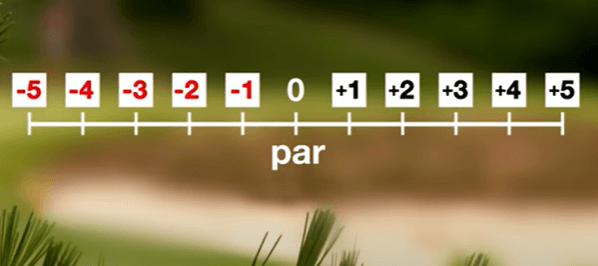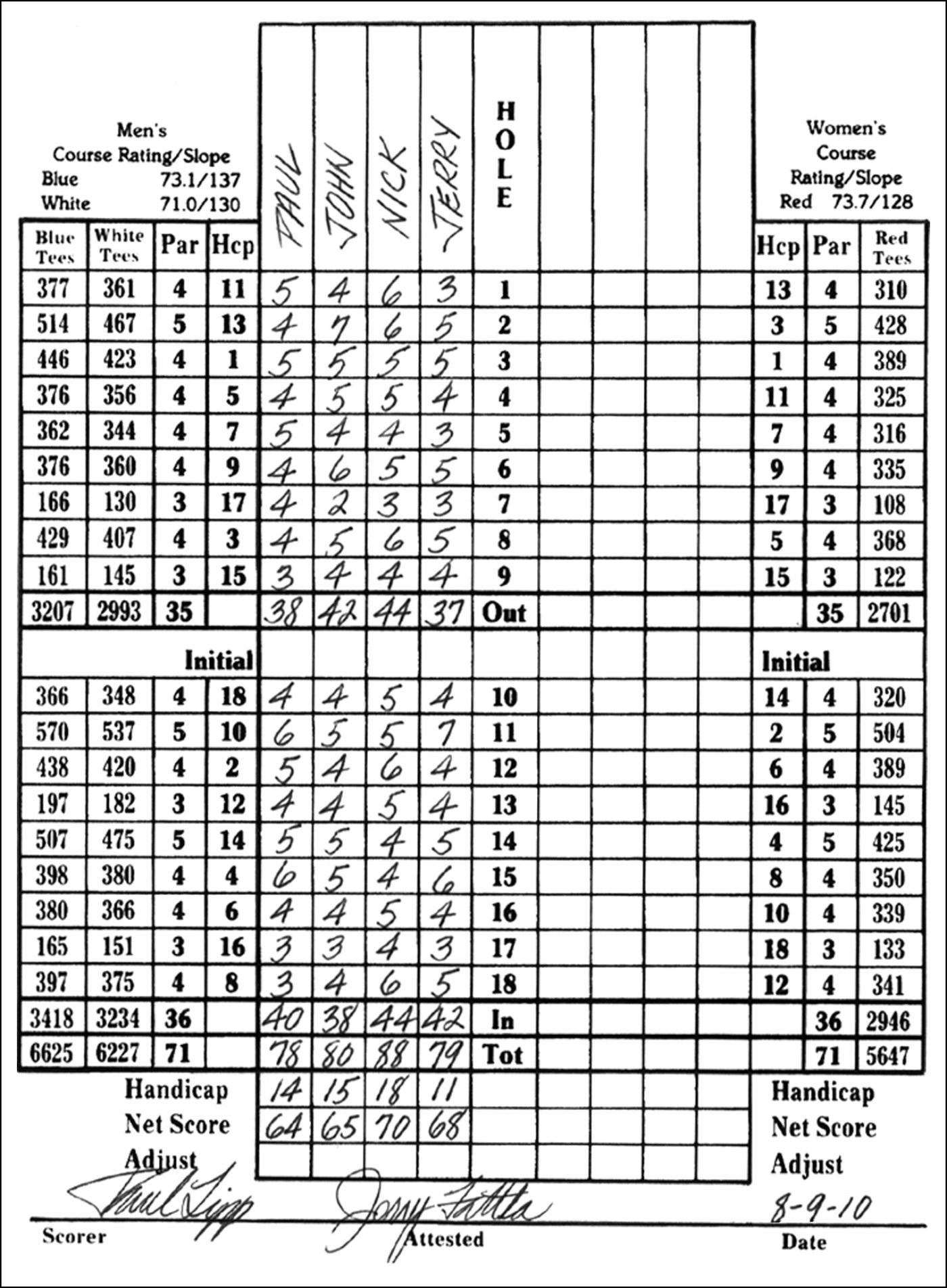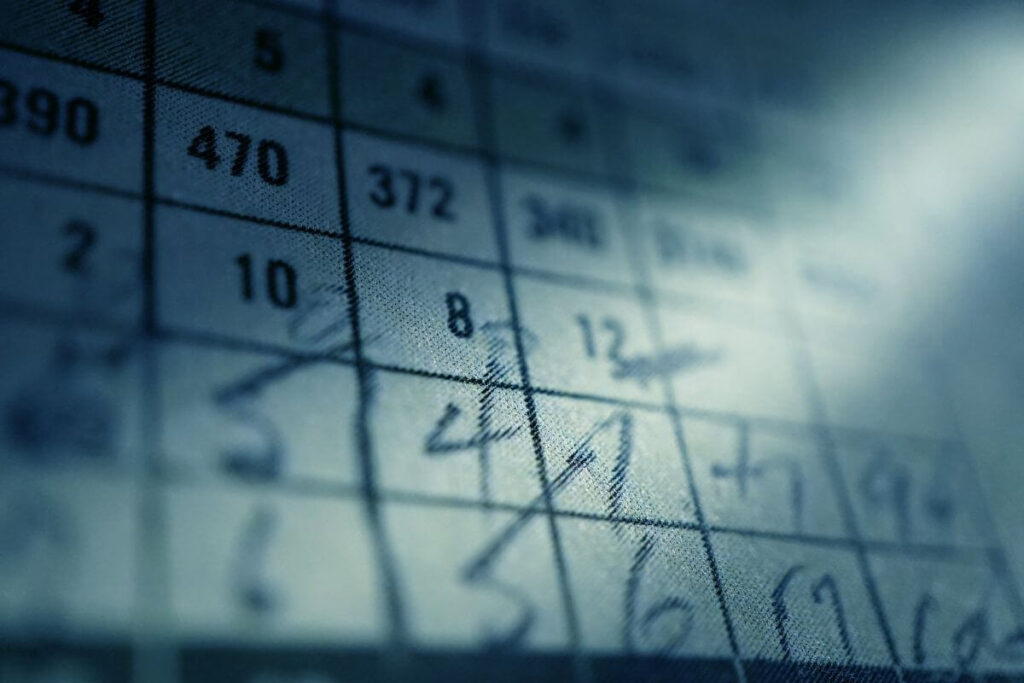From the first drive to the last putt, golf is a game filled with numbers, statistics and math. You’ll find numbers everywhere in golf. They are on your golf balls, golf clubs and most important your scorecard.
The scoring method most commonly used is called stroke play where a player counts the number of strokes made per each hole. At the conclusion of the round, golfers total up their score for each of the holes and the player with the lowest score wins.
The scorecard lists the holes and the length in yards from the tee markers to the center of the green.
Players should write the score for each hole on the scorecard. Total the first nine holes and add in the score of the next nine holes for a gross score. If handicaps are used, the player’s course handicap is usually subtracted from the gross score giving you a net score at the end.
The scorecard also lists par for the course, with par for each hole usually set at 3, 4 or 5 strokes.
(Par is the expected score for a hole or for a round.)
Most 18 hole golf courses will fall into a total par of 72. This is made up by a total of the pars on each of the holes.
Scores can also be determined by comparing the number of strokes to par. For example, if the first hole has a par of 4, and the player made 5 strokes, that’s called one over par or +1 (boogey).
If a player scored a 3 on the first hole, that’s called one under par or -1 (birdie).
Table of Contents
Understanding Plus and Minus In Golf Scoring
A plus or minus with a number indicates whether it is positive (greater than 0) or negative (less than 0).
Negative numbers in golf are a good thing unlike those seen in weather temperatures, the stock market, and financial statements.
Think of par as 0 on a number line with under par or negative numbers to the left of 0, and over par or positive numbers to the right.

Say the player is one stroke under par on 5 holes, one stroke over par on 4 holes and at par or even for all the others. From par, move to the left once per each stroke under par and then to the right for each stroke over par. The gross score is one under par (-1)
Similarly, if par is 72, subtract the 5 under par strokes and then add the 4 over par strokes for a gross score of 71.
(-5+4= -1) That is one under par or minus one.
Traditionally, when you take a look at scoreboards or leader boards, you’ll see scores expressed in relation to par with numbers colored red and black or with plus and minus.
In tournaments, golfers play multiple rounds over several days. The scores from each round are carried forward to the next day creating an aggregated or combined score.
Aggregated scores can total into the hundreds, so leaderboards track the golfer’s scores according to the number of strokes over or under par to the number of holes played.
This is very helpful in trying to gage how you are doing in the competition, but most important how you are doing against other players in the competition.
Making The Cut
At the USGA’s Open Championships, officials cut the number of players after 36 holes have been played. Players with the best 60 scores including ties continue to play. Scoring statistics help project what’s called the ‘Cut Score’. This is the score a player must shoot in order to continue in the competition.
Officials take the actual scores for the holes that have been completed and add it to an average score for each of the holes that they’ve yet to play. These officials are pretty good at predicting what that number is going to be that they need to get in order to make the cut.
Apart from competition, scoring statistics can help players improve their play. Looking at stats and analysing them is a great way to figure out what you did well and where you need to work on. For example, if you have 40 putts in a round and you shoot 75 then you may need to work on your putting.
Marking Your Score Card
Scorecards can be a little daunting when you first look at them as they contain a lot of numbers and little boxes. The image below shows a typical golf scorecard:

Though filling out scorecards may appear tedious, it is actually simpler than it looks.
Say your handicap is 9 and your partner’s is 14. That means you’re going to give him 5 strokes over the course of the round. He gets those strokes at the holes rated the most difficult. That’s logical. Equally logical is the fact that these holes are handicapped 1 through 5. So mark those “stroke holes” before you begin.
After the match begins, keep track of the score with simple pluses or minuses in a spare row of boxes.
In stroke play, you’re expected to keep and score your playing companion’s card. His name is at the top of the card, his handicap in the box at the bottom. All you have to do is record his score for each hole in the box provided. You don’t even have to add it up because you’re only responsible for the hole-by-hole score, not the total.
Match Play
In matchplay, you don’t have to write down any score. The only thing that matters is the state of the game between you and your opponent.
In match play, the score is recorded as holes up or holes down. Say your partner’s score on the first hole was 4, and your score was 5, and you received no strokes on that hole. He’s now one up. Because each hole is a separate entity, you don’t need to write down your actual score; you simply count the number of holes you’ve won or lost.
In fact, if you’re having a particularly bad time on a given hole, you can even pick up your ball and concede the hole. All you lose is that hole. Everything starts fresh on the next tee. Such a head-to-head match ends when one player is more holes up than the number of holes remaining.
Thus, matches can be won by scores of four and three.
All that means is that one player was four holes ahead with only three left, the match finishing on the 15th green.
Stroke Play
Strokeplay (or medalplay) is different. It’s strictly card-and-pencil stuff. Now you’re playing against everyone else in the field or against that elusive standard, par—not just your playing companion.
All you do is count one stroke each time you swing at the ball. If it takes you five strokes to play the first hole, you write 5 on your card for that hole. Well, your opponent does —your playing partner keeps your official score, although you can track it as well if you want. The card in your pocket has your playing companion’s name on it.
At the end of the round, he signs his name to your card and gives it to you; you do the same with his card. After you’ve checked your score for each hole, you also sign your card. Then, if you’re in an official tournament, you hand your card to the scorers.
If you’re playing a casual round, you record your score on the computer.
Take care when checking your card. One Rules of Golf quirk is that you’re responsible for the accuracy of the score recorded under your name for each hole—your companion isn’t.
Any mistakes are deemed to have been made by you, not him. And you can’t change a mistake later, even if you have witnesses. Take the case of Roberto DeVicenzo at the 1968 Masters. Millions of spectators and TV viewers saw him make a 3 on the 17th hole in the final round. But the man marking his card, TommyAaron, mistakenly marked a 4.
Checking his score after the round, DeVicenzo failed to notice the error and signed his card. The mistake cost him the chance to win in a playoff with Bob Goalby. DeVicenzo had to accept ascore one higher than he actually shot and lost by that one stroke. Tragic.
After realizing his mistake, poor DeVicenzo said, “What a stupid I am!”
One last thing: Don’t worry about the addition on your card. You aren’t responsible for that part. As long as the numbers opposite each hole are correct, you’re in the clear.



